The Microsoft Surface Studio Review
by Brett Howse on January 20, 2017 8:00 AM EST- Posted in
- Desktop
- Microsoft
- Surface
- Surface Studio
GPU Performance
Since the review unit is the GTX 980M model, the Surface Studio results will be the best case scenario for this device, and anyone with the GTX 965M will end up with significantly less GPU performance. With a 4500x3000 resolution display, gaming at the machine's native resolution is going to be a challenge even if the Studio had a GTX 1080, but most games will not run at the default resolutions in any appreciable way. That isn’t always the case though, and we’ll go through that here.
It’s also worth noting that the GTX 980M in the Surface Studio is the 4 GB model, rather than the 8 GB mobile variant which was available. There are games like Rise of the Tomb Raider which require more than 4 GB of vRAM if run at maximum settings, but the GTX 980M is likely going to struggle at those settings regardless.
This is not a dedicated gaming system, but some of our gaming tests were run just to see how the GTX 980M performs in the Studio.
3DMark

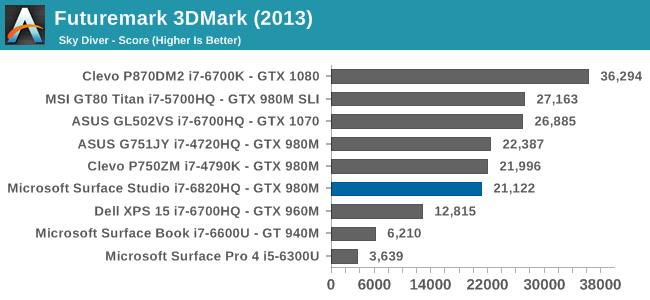
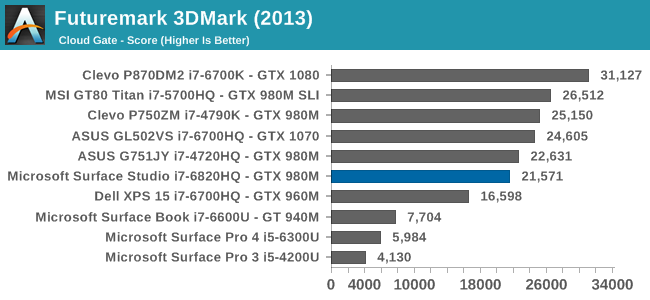
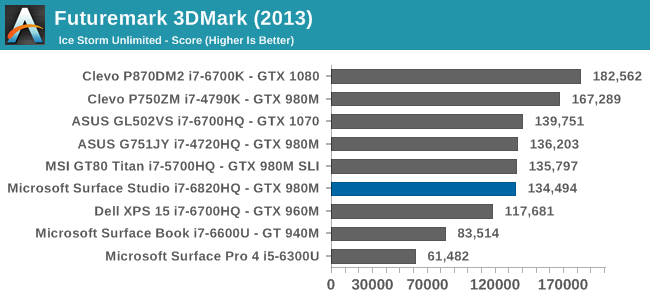
Futuremark’s 3DMark offers several different tests, with varying degrees of complexity. Fire Strike is the most difficult test in this grouping, followed by Sky Diver, Cloud Gate, and Ice Storm Unlimited. As the tests get less complex, they tend to become more CPU bound, and the scores reflect this. Compared to the Clevo systems which are here because they represent desktop class components, the Surface Studio can’t keep up with it’s mobile CPU.
Dota 2
Valve’s Dota 2 is a great benchmark game because it can be played on such a wide variety of hardware. The downside of it is that Valve continues to update it, which can change the performance somewhat, but regardless it’s a game that is playable on devices integrated GPUs, all the way up to SLI gaming rigs.
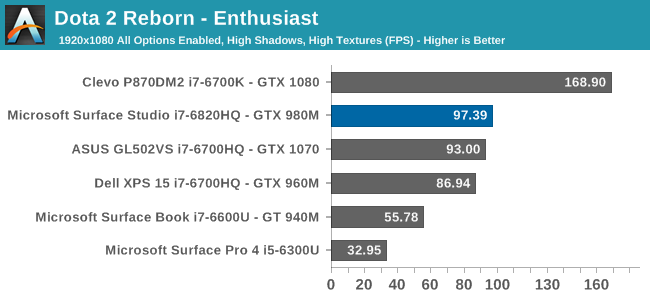
The GTX 980M is not the major limiting factor here, since even at 1920x1080 enthusiast settings, the game ends up being mostly CPU bound., but it can easily play at about 100 frames per second. Since this game is a bit lighter on the GPU, it is a perfect test bed to try out gaming at the native resolution

The average frame rate, even at 4500x3000 with all of the settings turned on, is still quite good for this type of game, and it is easily playable. Even the minimum frame rate is not too bad considering the number of pixels being driven. I would say it’s unlikely many competitive Dota 2 gamers will choose the Surface Studio as their gaming rig, but Dota 2 looks amazing at this resolution.
Tomb Raider
Even though Tomb Raider is getting a bit old now, and there’s even a sequel to this game which we normally test, Rise of the Tomb Raider was skipped because it won’t run at 1920x1080 Enthusiast settings on a GPU with 4 GB of vRAM or less. Regardless, Tomb Raider can still be a very demanding game.
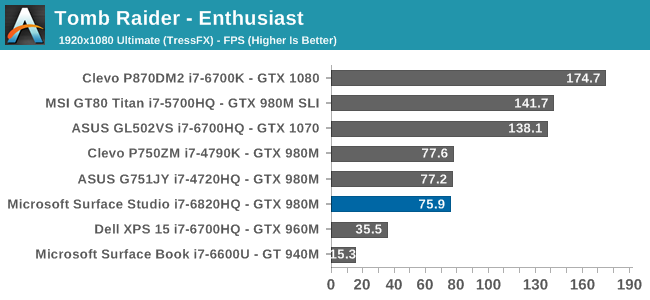
The GTX 980M is certainly the limiting factor here, and the Studio slots in right with the other GTX 980M systems. This game is very playable at 1080p settings, but is completely unplayable at 4500x3000. Setting the options to the lowest possible settings does get acceptable framerates, but the texture quality is so poor that it is not worth it.
Civilization VI
The latest version of Civilization has already burned too many of my hours for me to admit, and it can be a demanding game, although it tends to be CPU bound as well. Luckily it doesn’t need a huge framerate to be playable though.

Certainly playable, but nothing to get too excited about. Since this is another game with a wide range of performance targets, it was also tested at 4500x3000. In order to get playable results, the settings had to be turned to Low, but it didn’t really impact the look of the game as dramatically as you would expect. At 4500x3000 Low, the Studio managed 53 FPS.
Bioshock Infinite
The final game tested is also an older game, and it was picked in the hopes that it would be playable at 4500x3000, but alas, that was not the case. This game can still be demanding on the mobile GPUs, even after this much time.

You are pretty much stuck playing this around the 1080p level, even with the GTX 980M. It might be able to handle 1440p, but that would likely be it.
GPU Conclusion
Without harping on this even further, the Maxwell based GPU was a safe, but ultimately unsatisfying choice for Microsoft to make. A premium device like this deserves the latest generation GPU, especially with this kind of resolution. A GTX 1070 would double the performance of the Surface Studio when gaming, and although that’s not what this device is targeted at, Pascal would be a better choice for other tasks as well.
Storage Performance
Microsoft opted for a hybrid storage system. They didn’t want to ship the Surface Studio desktop with just a 256 GB or 512 GB solid state drive, so they decided on leveraging Intel’s Rapid Storage Technology to pair a relatively slow 5400 RPM hard drive (a Seagate-Samsung Spinpoint M9T in the review unit) with a fast SSD. The user doesn’t see the separate drives, so they can just use the system as if it was a single drive. It’s not quite the same implementation as Apple’s Fusion Drive, although it ends up being a similar result.
The base model only has a 64 GB SSD, and thanks to the iFIxit teardown, we can see the 64 GB SSD is just a SATA model as well, which is going to impact performance a lot compared to a PCIe based SSD. Luckily, both the mid and high end models both come with a 128 GB PCIe SSD for the cache. Thanks to the same teardown, we know it’s possible to upgrade the storage completely, although that’s an expensive proposition on top of the already high asking price of this device.
Intel uses Smart Response Technology as part of the Rapid Storage Technology to migrate data around between the two drives, and it attempts to keep your most used data on the SSD for quick access. The larger the SSD, the more this will be able to be done, so bigger is better. But let’s check out a quick performance run using CrystalDiskMark.
The PCIe SSD is a pretty good performer. Considering the small capacity, the write speeds are quite good.
Let’s not mince words though. A pure SSD solution would be better. Even with 128 GB of cache, eventually you are going to end up hitting the spinning drive for file access, and it’s going to seem very slow. However, for day-to-day use, the experience is better than expected. In many ways, it acts very much like a system with a pure SSD when it comes to boot times and the like, and most applications are cached and end up launching very quickly. For many people, this could be a non-issue, but it is still difficult to justify why there is not even an option for one of the Surface Studio models to offer a more modest sized SSD, in the 512 GB range, as a boot drive, and then the spinning drive as a separate drive for storage. Perhaps this will come later. This is one of the most expensive devices we’ve ever tested, and it’s also the first to come with a hybrid drive since the Apple Fusion iMac. As it stands now, the hybrid drive in the Studio is a good compromise between the Terabytes of storage desktop users are used to, and the performance of a SSD.


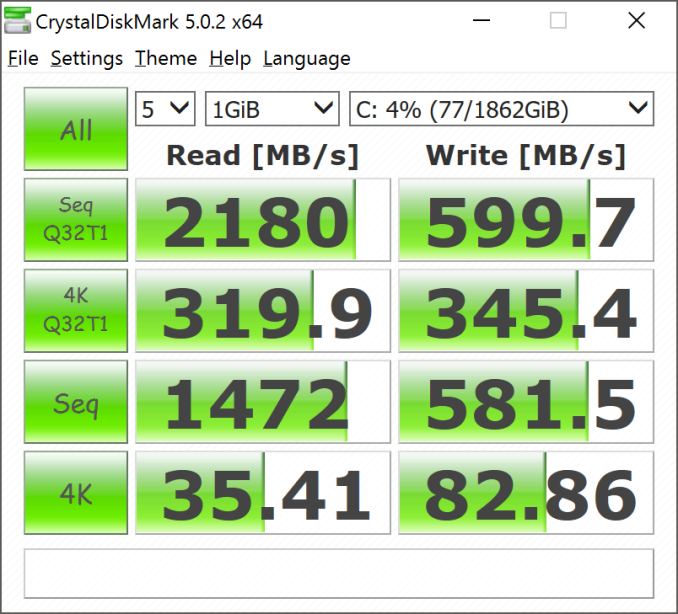








197 Comments
View All Comments
fanofanand - Monday, January 23, 2017 - link
My company employs over 260,000 people, and we just got WIN7 last year. We still have some users on XP. So "it takes a couple years for the enterprise world to catch up" is exactly right. Don't underestimate the need for compatibility with legacy applications in older, larger companies. Besides that, it isn't exactly a small undertaking to swap out the OS (or PCs for that matter) when you are literally dealing with hundreds of thousands of users. The enterprise world is VERY slow to adapt outside of Silicon Valley (or the tech sector in general).BrokenCrayons - Friday, January 20, 2017 - link
The Surface Book's biggest problem is its awful hinge design that doesn't let you fully close the system like pretty much every other clamshell design ever. It leaves that awkward gap to keep the screen from making contact with the keyboard that Microsoft couldn't figure out how to recess deep enough to keep it off the screen were they to give it a more effective hinge. I can't imagine anyone would examine the thing and be impressed by those painfully obvious oversights.Friendly0Fire - Friday, January 20, 2017 - link
Funny, the hinge is actually one of the things I like most about the SB. It means the keyboard isn't recessed and I don't have key markings on my screen every time I open it.It's not because it's different that it's bad, you know?
BrokenCrayons - Friday, January 20, 2017 - link
Key blemishes on a screen are as much of an indication of poor design as the shortcut Microsoft took with the Surface Book's hinge. Either way, you're the victim of thoughtless engineering. Though the biggest problem with the Surface Book hinge isn't really the fact that it underscores the error with keyboard placement, but that it robs the entire system of structural strength when closed. Instead of the whole system accepting pressure and distributing it across the entire chassis, one half or another will be forced to endure those forces alone.There's nothing wrong with finding the appearance appealing. It's simply that in either an attempt to create a visual difference or as compensation for poorly thought out system design, Microsoft selected the hinge to the detriment of its customers. It's not a big deal, really. The Surface Book is an inexpensive little system so there's not much lost if one is damaged. It just seems like thoughtlessness on the part of the company demonstrated in a very visual manner for sketchy justification.
Devo2007 - Friday, January 20, 2017 - link
Surface Book inexpensive? Oh, to have disposable income like that to consider a $2000 laptop inexpensive enough to consider it "not much lost if damaged."BrokenCrayons - Friday, January 20, 2017 - link
Money really isn't the point anyway. No matter what the cost relative to income, people reasonably expect their computers to be designed well and to function without a great deal of trouble. I don't think the Surface series in general has been able to live up to the reputation Microsoft is attempting to give it through its marketing. The SB in particular just doesn't translate well from marketing material to functionality due in part to a variety of problems associated with the hinge (and a few other software/hardware glitches). They have earned a reputation as quirky and unreliable which doesn't help Microsoft land sales.fanofanand - Monday, January 23, 2017 - link
Come back down to earth Mr Crayons, the SB is NOT an inexpensive product. I agree with the rest of your post but you are showing your elitism with a statement like that.BrokenCrayons - Monday, January 23, 2017 - link
I'm sorry! I was really trying to focus on the design and not so much the cost.Manch - Sunday, January 22, 2017 - link
That hinge can handle a lot of stress. Its been proven that durability is not an issue. The purpose of the hinge design was to counter the screen/tablet weight for proper balance when in laptop mode. So what is it exactly that's so poor in its design?BrokenCrayons - Monday, January 23, 2017 - link
You'll see it a couple posts up from the one you replied to.